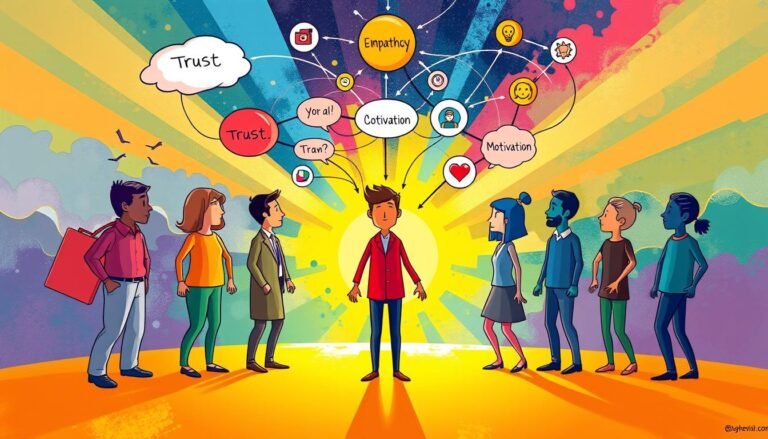Employee Turnover: How Organizational Psychology Can Help You Retain Top Talent
Are you losing your best employees faster than you can replace them? Employee turnover is a big worry for businesses all over the world. It’s not just about money; it’s about keeping a strong, productive team. Organizational psychology gives insights into keeping your top performers.
In today’s job market, knowing what makes employees happy and engaged is key. With low unemployment in many places, workers have more choices than ever. This makes keeping employees a big challenge for companies.
But, pay isn’t always the main reason people stay. A PayScale study showed that even when workers are paid well, they might still feel underpaid. Trust in leadership, recognition, and chances for career growth are more important for keeping employees happy and loyal.
Key Takeaways
- Employee turnover can cost businesses up to $1 trillion annually
- Engaged employees are less likely to leave their organizations
- Trust in leadership is crucial for employee retention
- Recognition and career growth opportunities are key factors in job satisfaction
- Organizational psychology can help identify and address root causes of turnover
Understanding the Impact of Employee Turnover
Employee turnover is a big problem for businesses. It hurts their money and how they work together. High turnover rates cause big financial and work problems. It’s key for companies to understand how it affects them.
Costs associated with turnover
Turnover costs are more than just hiring and training new people. In the U.S., turnover costs can be up to $1.8 trillion a year. This includes time for interviews, training, and getting up to speed.
Effect on productivity and morale
High turnover hurts how well a team works and how happy they are. When people leave often, it messes up the team’s work. It makes the team work harder and can make the company look bad. This makes it hard to find good people to work there.
Importance of retention strategies
Keeping employees is key to a happy and stable team. By keeping employees happy, companies can keep them longer. Looking at why people leave helps companies keep their best workers.
| Retention Strategy | Benefits |
|---|---|
| Career development programs | Enhanced employee satisfaction, reduced turnover |
| Regular feedback and recognition | Improved engagement, increased loyalty |
| Competitive compensation packages | Attracts top talent, reduces voluntary turnover |
| Work-life balance initiatives | Higher job satisfaction, lower stress-related turnover |
Understanding and fixing employee turnover problems helps companies. They can have a happier, more productive team. This leads to better business results and success in the long run.
The Role of Organizational Psychology in Talent Management
Organizational psychology is key in talent management. It helps companies find and keep the best employees. It gives insights into how employees behave, what motivates them, and their job satisfaction.
By using psychology, businesses can make plans to keep employees happy and reduce turnover.
Studies show that good talent management makes employees more engaged and less likely to leave. A review of 43 studies found that the right strategies boost engagement and lower turnover. This shows how important psychology is in the workplace.
“Talent management has been recognized to improve productivity, job satisfaction, motivation, and organizational commitment, and reduce turnover intention.”
Understanding work engagement is crucial. It includes vigor, dedication, and absorption. Psychologists use this to make work environments better and increase job satisfaction.
By focusing on these areas, companies can keep their employees happy and reduce turnover.
| Factor | Impact on Employees | Organizational Benefit |
|---|---|---|
| Work Engagement | Increased job satisfaction | Lower turnover rates |
| Talent Management Practices | Enhanced motivation | Improved productivity |
| Organizational Engagement | Stronger connection to company | Higher employee retention |
Psychologists also help with challenges like the Great Resignation. They understand what drives employee choices. This helps companies keep their best workers.
This is especially important today, when finding talent is hard. Without the right people, businesses can struggle.
Identifying Root Causes of Employee Turnover
It’s important to know why employees leave to lower turnover rates. Exit interviews and job satisfaction surveys help uncover what keeps employees engaged. Let’s look at the main reasons for employee turnover.
Poor Management Practices
Bad leadership can really hurt job satisfaction. Employees often leave because they feel unsupported or not valued by their managers. Poor management, like favoritism and poor communication, are big reasons for high turnover.
Lack of Career Growth Opportunities
For 13 years, the main reason for leaving has been the lack of growth and development chances. Companies that don’t offer learning and development lose their best talent to competitors. It’s key to have clear career paths and skill development programs.
Work-Life Balance Issues
Employees who are overworked or can’t balance work and life may look for new jobs. This is especially true for those with families or other commitments. It’s vital to tackle workplace stress to keep employees happy and retained.
| Factor | Impact on Turnover | Potential Solution |
|---|---|---|
| Poor Management | High impact | Leadership training programs |
| Lack of Growth | Primary reason for 13 years | Career development initiatives |
| Work-Life Balance | Increasing concern | Flexible work arrangements |
By tackling these root causes, companies can improve retention and have a more engaged team. Regular check-ins, clear communication, and focusing on employee well-being are key. These strategies help reduce turnover and create a better work environment.
Creating a Positive Work Culture to Reduce Attrition
A positive work culture is crucial for keeping employees. Studies reveal that 1 in 4 U.S. workers dread their jobs. This shows the need for a change in work culture.
Companies that focus on making employees happy see great results. Shockingly, 57% of employees who left in 2021 said they felt disrespected. This highlights the need for a respectful workplace.
Workplaces that encourage learning see 30%-50% more engagement. Fun activities at work can also boost creativity and purpose. Companies with happy employees can see a 21% profit increase.
“Culture is not just one aspect of the game, it is the game.” – Louis V. Gerstner, Jr.
To build a positive work environment:
- Encourage open communication
- Recognize employee achievements
- Promote work-life balance
- Offer growth opportunities
- Foster team collaboration
77% of job seekers look at a company’s culture before applying. By focusing on culture, you attract the best talent and lower turnover. This benefits both employees and the company.
Effective Strategies for Attracting Top Talent
Attracting and keeping top talent is a big challenge today. With 61% of employers struggling to keep employees and 73% finding it hard to attract them, good talent management is essential. Let’s look at some ways to draw and keep the best professionals in your team.
Employer Branding
A strong employer brand is key to attracting talent. It shows your company’s values, culture, and what makes you unique. Create a story that shows why your organization is special. Use social media, your website, and employee stories to share your brand and make a good impression on potential candidates.
Competitive Compensation Packages
Money matters when attracting talent. Offer salaries or wages that match the industry standard. Remember, replacing an employee can cost up to nine months of their salary. Include benefits like flexible work, wellness programs, and learning opportunities to make a complete package that meets different needs.
Showcasing Growth Opportunities
Career growth is important to many job seekers. Show the chances for advancement in your company. Have regular meetings to talk about career goals, offer training, and help with education costs. Investing in employee growth attracts new talent and keeps current employees happy and engaged.
| Strategy | Impact on Attraction | Impact on Retention |
|---|---|---|
| Strong Employer Brand | Increased applicant quality | Higher employee pride |
| Competitive Compensation | Larger talent pool | Reduced turnover |
| Growth Opportunities | Attracts ambitious candidates | Improved job satisfaction |
By using these strategies, you can build a workplace that attracts and keeps top talent. A complete approach to talent management is essential for a strong, motivated team.
Employee Turnover: Psychological Factors at Play
Deciding to leave a job is a complex mental and emotional process. Psychological factors are key in keeping employees happy and engaged. Feeling valued, having meaningful work, and belonging are crucial for staying.
Trust is essential in keeping employees. Leaders who show empathy, logic, and authenticity build strong bonds. This trust helps create a positive work culture and boosts employee engagement.
Having access to information and decision-making rights makes employees feel important. When they feel empowered and included, they are happier at work.
“Employees who feel valued and trusted are more likely to stay committed to their organization.”
A study with 270 employees in Chinese organizations found important insights. Emotional exhaustion, work engagement, and role conflict greatly affect turnover intentions. It shows the need to focus on mental health to improve job satisfaction and lower turnover.
- Emotional exhaustion is a significant predictor of high turnover intention
- Work-related stress mediates the relationship between psychological factors and turnover intentions
- Job satisfaction acts as a moderator between work-related stress and turnover intentions
Understanding these psychological factors helps organizations keep employees. By creating a positive work environment, building trust, and caring for employee well-being, companies can lower turnover. This keeps the workforce motivated and engaged.
Implementing Retention-Focused Leadership Practices
Leadership is key to keeping employees happy and on board. Good leaders build trust, encourage growth, and empower their teams.
Developing Trust and Transparency
Trust is the base of strong work relationships. Leaders who talk openly and honestly make their teams feel important and safe. This openness lowers uncertainty and boosts loyalty, helping keep employees around.
Providing Regular Feedback and Recognition
Feedback helps employees know how they’re doing and where they can improve. Praising good work is just as crucial. Research shows that real recognition can cut down on job hopping by 55% and burnout by 68%.
Empowering Employees Through Decision-Making
Letting employees help make decisions makes them feel more invested. This approach not only raises engagement but also brings in fresh ideas, leading to better results.
Using these leadership methods can really help keep employees. Here are some interesting facts:
| Factor | Impact on Retention |
|---|---|
| Manager’s Role | 75% of employees leave due to their manager |
| Leadership Training | 82% of new managers lack formal people leadership skills |
| Preventable Turnover | 52% of exits could be prevented by managers |
| Engagement Discussions | 51% of departing employees had no recent job satisfaction talks |
By focusing on these leadership practices, companies can make their workplaces more engaging. This can lead to less turnover and more long-term commitment from employees.
Leveraging Data and Analytics in Retention Efforts
In today’s world, companies use people analytics to make smart choices about their teams. They look at data to understand how employees act, spot trends, and create plans to keep them. This helps in making informed decisions about their workforce.
People analytics is key in figuring out why employees leave. For instance, Visier found that when one team member quits, others are 9.1% more likely to leave soon. This info helps companies act fast to stop more people from leaving.
Using data to make decisions can really help keep employees. IBM saw a 20% drop in turnover in areas where they used analytics. Deloitte also cut new hire turnover by 30% in a year by improving how they welcomed new staff.
Predictive analytics is also a big help in keeping employees. By looking at things like pay, promotions, and training, companies can spot who might leave. This lets them take steps to keep those employees.
| Company | Analytics Implementation | Result |
|---|---|---|
| IBM | Predictive analytics for talent acquisition | 30% decrease in employee turnover |
| Atos | Analysis of exit interviews and employee data | 31% decrease in attrition |
| IBM | AI prediction of employee satisfaction | 20% increase in retention rates |
By using people analytics and making choices based on data, companies can keep their teams better. They can cut down on turnover costs and make their workforce happier and more productive.
Tailoring Retention Strategies to Different Employee Segments
Effective talent management means creating special plans for each group of employees. Companies need to understand that a single plan won’t work for everyone. Each group has its own needs.
Generational Differences
Each generation wants different things from work. Baby Boomers like stability and old-school benefits. Millennials and Gen Z want balance and chances to grow in their careers. Knowing these differences helps create better plans for keeping employees happy.
Career Stage Considerations
People at different stages of their careers need different things. Newbies want to learn and grow. Those in the middle want to lead. Older workers want to be recognized and share their knowledge.
Role-specific Retention Approaches
Jobs have their own challenges and what motivates them. Tech jobs need new projects. Jobs that deal with people need better support. Making plans for each job can really help keep employees happy and stop them from leaving.
| Employee Segment | Key Retention Focus | Effective Strategy |
|---|---|---|
| Gen Z | Career Growth | Mentorship Programs |
| Mid-career Professionals | Work-life Balance | Flexible Work Arrangements |
| Senior Employees | Recognition | Leadership Roles in Special Projects |
Creating special plans for each group can really help keep employees happy and reduce costs. Studies show that happy employees are much less likely to leave. This shows how important it is to tailor plans for each group.
Conclusion
Employee turnover is a big problem for businesses in many fields. Organizational psychology helps find ways to solve this issue. By using strategies made just for their needs, companies can lower turnover and save money.
Turnover does more than just cost money. It also hurts productivity, morale, and growth. Smart companies are using tools like Applauz to make work better and happier.
While some turnover is okay, too much is bad. Places like hotels and hospitals often lose more employees. To fix this, companies need to keep improving how they keep workers. They should offer chances for growth, fair pay, and a good work-life balance.
Using psychology in the workplace helps create a culture that workers want to stay in. This not only keeps employees but also brings in the best ones. It’s a key to lasting success for businesses.
Source Links
- The Psychology Behind Employee Retention and Turnover: The Fight for Relevance | UKG
- Understanding the psychology behind employee turnover and strategies to prevent it
- HR’s complete guide to employee retention | Culture Amp
- Effects of High Turnover Among Employees
- The Impact of Employee Turnover on Organizational Culture
- Connecting the organizational incomes and outcomes: a systematic review of the relationship between talent management, employee engagement, and turnover intention
- Frontiers | Connecting the organizational incomes and outcomes: a systematic review of the relationship between talent management, employee engagement, and turnover intention
- 7 Common Causes of Employee Turnover & Professional Help | Work Institute
- High employee turnover? The real causes and impact
- How Workplace Culture Impacts Your Employee Turnover
- Council Post: Improving Employee Retention In 2023 With A Positive Workplace Culture
- How to attract and retain top talent in 2024
- 14 Effective Employee Retention Strategies
- 15 Effective Employee Retention Strategies In 2024
- Employee turnover: Definition, causes and more
- Signifying the Relationship Between Psychological Factors and Turnover Intension: The Mediating Role of Work-Related Stress and Moderating Role of Job Satisfaction
- Factors impacting employee turnover intentions among professionals in Sri Lankan startups
- How to Improve Employee Retention and Reduce Turnover
- Solving Employee Retention & Turnover: A Leadership Perspective
- How To Reduce Employee Turnover with Workforce Analytics | Visier
- How can HR data analytics enhance employee retention strategies?
- Keep Employees with Crucial Skills from Walking Out the Door
- 8 employee retention strategies that work
- Employee Turnover Explained: A Comprehensive Guide for 2023
- The fluctuation rate: a key figure for employee retention
- The Real Cost of Employee Turnover (And How to Prevent It) | Jobvite







